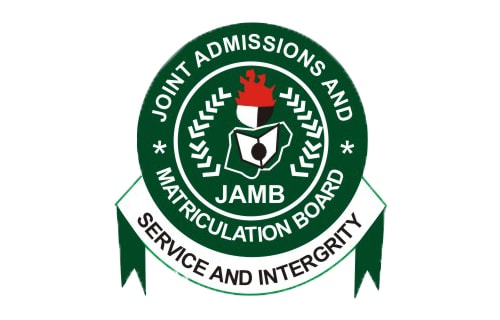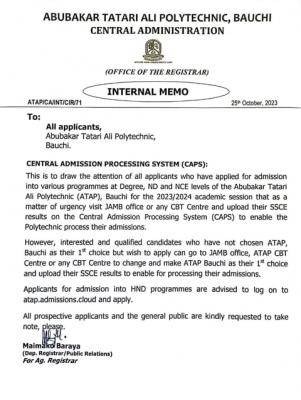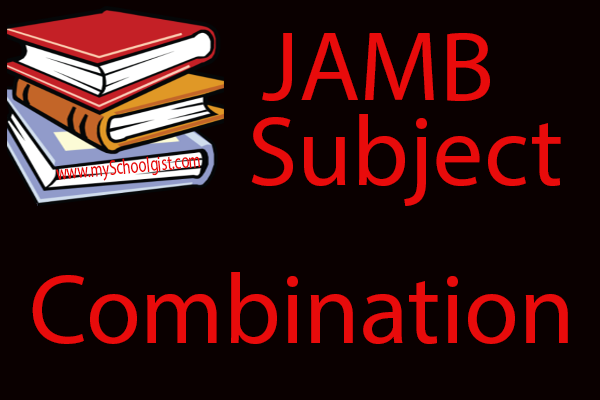
The current official Chemistry JAMB Syllabus for UTME candidates is now available. The JAMB syllabus contains all the topics UTME candidates writing the JAMB CBT exam are expected to cover before the examination to ensure they are adequately prepared for the examination.
If you have been looking to get the JAMB Syllabus online, look no further. We understand that JAMB usually provide this syllabus for candidates in a CD. However, we have discovered that many candidates are unable to access to access this due to one reason or the other.
We have therefore decided to make it easier for you by making it available online so you can view it using any device that can access internet including your mobile phones.
Here we have provided you the detailed, complete and current JAMB Syllabus for Chemistry. To view the JAMB Syllabus for all subjects, go to: Official JAMB Syllabus For All Subjects
Current JAMB Syllabus – Chemistry
The aim of this 2016/2017 Unified Tertiary Matriculation Examination (UTME) syllabus in Chemistry is to prepare the candidates for the Board’s examination. It is designed to test their achievement of the course objectives, which are to:
(i) understand the basic principles and concepts in chemistry;
(ii) interpret scientific data relating to chemistry;
(iii) deduce the relationships between chemistry and other sciences;
(iv) apply the knowledge of chemistry to industry and everyday life.
Current JAMB Syllabus – Chemistry: DETAILED SYLLABUS/CONTENTS
| TOPICS/CONTENTS/NOTES | OBJECTIVES |
1. Separation of mixtures and purification of chemical substances(a) Pure and impure substances | Candidates should be able to: (i) distinguish between pure and impure substances; (ii) use boiling and melting points as criteria for purity of chemical substances; (iii) distinguish between elements, compounds and mixture; (iv) differentiate between chemical and physical changes; (v) identify the properties of the components of a mixture; (vi) specify the principle involved in each separation method. (vii) apply the basic principle of separation processes in everyday life. |
2. Chemical combinationStoichiometry, laws of definite and multiple proportions, law of conservation of matter, Gay Lussac’s law of combining volumes, Avogadro’s law; chemical symbols, formulae, equations and their uses, relative atomic mass | Candidates should be able to: (i) perform simple calculations involving formulae, equations/chemical composition and the mole concept; (ii) deduce the chemical laws from given expressions/statements/data; (iii) interpret graphical representations related to these laws; (iv) deduce the stoichiometry of chemical reactions. |
3. Kinetic theory of matter and Gas Laws(a) An outline of the kinetic theory of matter; | Candidates should be able to: (i) apply the theory to distinguish between solids, liquids and gases; (ii) deduce reasons for change of state; (iii) draw inferences based on molecular motion; (iv) deduce gas laws from given expressions/ statements; (v) interpret graphical representations related to these laws; (vi) perform simple calculations based on these laws, equations and relationships |
4. Atomic structure and bonding(a) (i)The concept of atoms, molecules and ions, the works of Dalton, Millikan, Rutherford, Moseley, Thompson and Bohr. | Candidates should be able to: (i) distinguish between atoms, molecules and ions; (ii) identify the contributions of these scientists to the development of the atomic structure; (iii) deduce the number of protons, neutrons and electrons from atomic and mass numbers of an atom; (iv) apply the rules guiding the arrangement of electrons in an atom; (v) identity common elements exhibiting isotopy; (vi) relate isotopy to mass number; (vii) perform simple calculations relating to isotopy; (viii) differentiate between the shapes of the orbitals; (ix) determine the number of electrons in s and p atomic orbitals; (x) relate atomic number to the position of an element on the periodic table; (xi) relate properties of groups of elements on the periodic table; (xii) identify reasons for variation in properties across the period and down the groups. (xiii) differentiate between the different types of bonding. (xiv) deduce bond types based on electron configurations; (xv) relate the nature of bonding to properties of compounds; (xvi) differentiate between the various shapes of molecules xvii) distinguish between ordinary chemical reaction and nuclear reaction; (xviii) differentiate between natural and artificial radioactivity; (xix) compare the properties of the different types of nuclear radiations; (xx) compute simple calculations on the half-life of a radioactive material; (xxi) balance simple nuclear equation; (xxii) identify the various applications of radioactivity. |
5. Air(a) The natural gaseous constituents and their proportion in the air. | Candidates should be able to: (i) deduce reason (s) for the existence of air as a mixture; (ii) identify the principle involved in the separation of air components; (iii) deduce reasons for the variation in the composition of air in the environment; (iv) specify the uses of some of the constituents of air. |
6. Water(a) Water as a product of the combustion of hydrogen and its composition by volume. | Candidates should be able to: (i) identify the various uses of water; (ii) identity the effects of dissolved atmospheric gases in water; (iii) distinguish between the properties of hard and soft water; (iv) determine the causes of hardness; (v) identify methods of removal of hardness; (vi) describe the processes involved in the treatment of water for town supply; (vii) distinguish between these phenomena; (viii) identify the various compounds that exhibit these phenomena. |
7. Solubility(a) Unsaturated, saturated and supersaturated solutions. Solubility curves and simple deductions from them, (solubility defined in terms of mole per dm3) and simple calculations. | Candidates should be able to: (i) distinguish between the different types of solutions; (ii) interpret solubility curves; (iii) calculate the amount of solute that can dissolve in a given amount of solvent at a given temperature; (iv) deduce that solubility is temperature-dependent; (v) relate nature of solvents to their uses; (vi) differentiate among true solution, suspension and colloids; (vii) compare the properties of a true solution and a �false’ solution. (viii) provide typical examples of suspensions and colloids. |
8. Environmental Pollution(a) Sources and effects of pollutants. | Candidates should be able to: (i) identify the different types of pollution and pollutants; (ii) specify different sources of pollutants (iii) classify pollutants as biodegradable and non-biodegradable; (iv) specify the effects of pollution on the environment; (v) identify measures for control of environmental pollution. |
9. Acids, bases and salts(a) General characteristics and properties of acids, bases and salts. Acids/base indicators, basicity of acids; normal, acidic, basic and | Candidates should be able to: (i) distinguish between the properties of acids and bases; (ii) identify the different types of acids and bases; (iii) determine the basicity of acids; (iv) differentiate between acidity and alkalinity using acid/base indicators; (v) identify the various methods of preparation of salts; (vi) classify different types of salts; (vii) relate degree of dissociation to strength of acids and bases; (viii) relate degree of dissociation to conductance; (ix) perform simple calculations on pH and pOH; (x) identify the appropriate acid-base indicator; (xi) interpret graphical representation of titration curves; (xii) perform simple calculations based on the mole concept; (xiii) balance equations for the hydrolysis of salts; (xiv) deduce the properties (acidic, basic, neutral) of the resultant solution. |
10. Oxidation and reduction(a) Oxidation in terms of the addition of oxygen or removal of hydrogen. | Candidates should be able to: (i) identify the various forms of expressing oxidation and reduction; (ii) classify chemical reactions in terms of oxidation or reduction; (iii) balance redox reaction equations; (iv) deduce the oxidation number of chemical species; (v) compute the number of electron transfer in redox reactions; (vi) identify the name of redox species in a reaction (vii) distinguish between oxidizing and reducing agents in redox reactions. (viii) apply oxidation number in naming inorganic compounds (ix) relate reagents to their oxidizing and reducing abilities. |
11. Electrolysis(a) Electrolytes and non-electrolytes. | Candidates should be able to: (i) distinguish between electrolytes and non- electrolytes; (ii) perform calculations based on faraday as a mole of electrons. (iii) identify suitable electrodes for different electrolytes. (iv) specify the chemical reactions at the electrodes; (v) determine the products at the electrodes; (vi) identify the factors that affect the products of electrolysis; (vii) specify the different areas of application of electrolysis; (viii) identify the various electrochemical cells; (ix) calculate electrode potentials using half- cell reaction equations; (x) determine the different areas of application of electrolytic processes; (xi) identify methods used in protecting metals. |
12. Energy changes(a) Energy changes(ΔΔH) accompanying physical | Candidates should be able to: (i) determine the types of heat changes (ΔΔH) in physical and chemical processes; (ii) interpret graphical representations of heat changes; (iii) relate the physical state of a substance to the degree of orderliness; (iv) determine the conditions for spontaneity of a reaction ; (v) relate ΔΔHθθ, ΔΔSθθ and ΔΔGθθ as the driving forces for chemical reactions; (vi) solve simple problems based on the relationships ΔΔGθθ= ΔΔHθθ -TΔΔSθθ |
13. Rates of Chemical Reaction(a) Elementary treatment of the following factors which can change the rate of a chemical reaction: | Candidates should be able to: (i) identify the factors that affect the rates of a chemical reaction; (ii) determine the effects of temperature on the rate of reactions; (iii) examine the effect of concentration/pressure on the rate of a chemical reaction; (iv) describe how the rate of a chemical reaction is affected by surface area; (v) determine the types of catalysts suitable for different reactions and their effects; (vi) determine ways of moderating these effects in chemical reactions. (vii) interpret reaction rate curves; (viii) solve simple problems on the rate of reactions; (ix) relate the rate of reaction to the kinetic theory of matter. (x) examine the significance of activation energy to chemical reactions. (xi) deduce the value of activation energy (Ea) from reaction rate curves. |
14. Chemical equilibraReversible reactions and factors governing | Candidates should be able to: (i) identify the factors that affects the position of equilibrium of a chemical reaction; (ii) predict the effects of each factor on the position of equilibrium; (iii) determine the effects of these factors on equilibrium constant. |
15. Non-metals and their compounds(a) Hydrogen: commercial production from | Candidates should be able to: (i) predict reagents for the laboratory and industrial preparation of these gases and their compounds. (ii) identify the properties of the gases and their compounds. (iii) compare the properties of these gases and their compounds. (iv) specify the uses of each gas and its compounds; (v) determine the specific test for each gas and its compounds. (vi) determine specific tests for Cl–, SO42-, SO32-, S2-, NH4+, NO3-, CO32-, HCO?3 (vii) predict the reagents for preparation, properties and uses HCl(g) and HCl(aq); (viii) identify the allotropes of oxygen; (ix) determine the significance of ozone to our environment. (x) classify the oxides of oxygen and their properties (xi) identify the allotropes of sulphur and their uses; (xii) predict the reagents for preparation, properties and uses of SO2 and H2S; (xiii) specify the preparations of H2SO4 and H2SO3, their properties and uses. (xiv) specify the laboratory and industrial preparation of NH3; (xv) identify the properties and uses of NH3; (xvi) identify reagents for the laboratory preparation of HNO3, its properties and uses; (xvii) specify the properties of N2O, NO, NO2gases. (xviii) examine the relevance of nitrogen cycle to the environment. (xix) identify allotropes of carbon; (xx) predict reagents for the laboratory preparation of CO2; (xxi) specify the properties of CO2 and its uses; (xxii) determine the reagents for the laboratory preparation of CO; (xxiii) predict the effects of CO on human; (xxiv) identify the different forms of coal: (xxv) determine their uses; (xxvi) specify the products of the destructive distillation of wood and coal; (xxvii) specify the uses of coke and synthetic gas. |
16. Metals and their compounds(a) General properties of metals | Candidates should be able to: (i) specify the general properties of metals; (ii) determine the method of extraction suitable for each metal; (iii) relate the methods of extraction to the properties for the metals; (iv) compare the chemical reactivities of the metals; (v) specify the uses of the metals; (vi) determine specific test for metallic ions; (vii) determine the process for the production of the compounds of these metals; (viii) compare the chemical reactivities of the compounds; (ix) specify the uses of these compounds; (x) specify the chemical composition of cement. (xi) describe the method of purification of bauxite; (xii) specify the ores of tin; (xiii) relate the method of extraction to its properties; (xiv) specify the uses of tin; (xv) identify the general properties of the first transition metals; (xvi) deduce reasons for the specific properties of the transition metals; (xvii) determine the IUPAC names of simple transition metal complexes (xviii) determine the suitable method of extraction of iron; (xix) specify the properties and uses of iron; (xx) identify the different forms of iron, their compositions, properties and uses. (xxi) identify the appropriate method of extraction of copper from its compounds; (xxii) relate the properties of copper and its compound to their uses. (xxiii) specify the method for the preparation of CuSO4; (xxiv) specify the constituents and uses of the various alloys mentioned. (xxv) compare the properties and uses of alloys to pure metals. |
17. Organic CompoundsAn introduction to the tetravalency of | Candidates should be able to: (i) derive the name of organic compounds from their general formulae; (ii) relate the name of a compound to its structure (iii) relate the tetravalency of carbon to its ability to form chains of compound (catenation); (iv) classify compounds according to their functional groups; (v) derive empirical formula and molecular formula, from given data; (vi) relate structure/functional groups to specific properties; (vii) derive various isomeric forms from a given formula; (viii) distinguish between the different types of isomerism; (ix) classify the various types of hydrocarbons; (x) distinguish each class of hydrocarbons by their properties; (xi) specify the uses of various hydrocarbons; (xii) identify crude oil as a complex mixture of hydrocarbons; (xiii) relate the fractions of hydrocarbons to their properties and uses; (xiv) relate transformation processes to quality improvement of the fractions; (xv) distinguish between various polymerization processes; (xvi) specify the process involved in vulcanization; (xvii) specify chemical test for terminal alkynes (xviii) distinguish between aliphatic and aromatic hydrocarbons; (xix) relate the properties of benzene to its structure (xx) compare the various classes of alkanols; (xxi) determine the processes involved in ethanol production; (xxii) examine the importance of ethanol as an alternative energy provider; (xxiii) distinguish the various classes of alkanols; (xxiv) differentiate between alkanals and alkanones; (xxv) compare the various types of alkanoic acids; (xxvi) identify natural sources of alkanoates; (xxvii) specify the methods for the production of soap, detergent and margarine. (xxviii) distinguish between detergent and soap; (xxix) compare the various classes of alkanamine; (xxx) identify the natural sources of carbohydrates; (xxxi) compare the various classes of carbohydrates; (xxxii) infer the products of hydrolysis and dehydration of carbohydrates; (xxxiii) determine the uses of carbohydrates; (xxxiv) specify the tests for simple sugars; (xxxv) identify the basic structure of proteins; (xxxvi) specify the methods and products of hydrolysis; (xxxvii) specify the various tests for proteins; (xxxviii) distinguish between natural and synthetic polymers; (xxxix) differentiate between addition and condensation polymerization processes; (xl) classify natural and commercial polymers and their uses; (xli) distinguish between thermoplastics and thermosetting plastics. |
18. Chemistry and IndustryChemical industries: Types, raw materials and | Candidates should be able to : (i) classify chemical industries interms of products; (ii) identify raw materials for each industry; (iii) distinguish between fine and heavy chemicals; (iv) enumerate the relevance of each of these industries; (v) relate industrial processes to biotechnology. |
Current JAMB Syllabus – Chemistry: RECOMMENDED TEXT BOOKS
1. New School Chemistry for Senior Secondary Schools, Ababio, O. Y. (2009), (Fourth edition), Onitsha: Africana FIRST Publishers Limited.
2. Senior Secondary Chemistry, Bajah, S.T.; Teibo, B. O., Onwu, G.; and Obikwere, A. Book 1 (1999), Books 2 and 3 (2000). Lagos: Longman.
3. Understanding Chemistry for Schools and Colleges, Ojokuku, G. O. (2012, Revised Edition), Zaria: Press-On Chemresources.
4. Essential: Chemistry for Senior Secondary Schools, (2008), 2nd Edition, I. A. Odesina, Lagos: Tonad Publishers Limited.
5. Countdown to WASSCE/SSCE, NECO, JME Chemistry, Uche, I. O.; Adenuga, I. J. and Iwuagwu, S. L. (2003). Ibadan: Evans.




